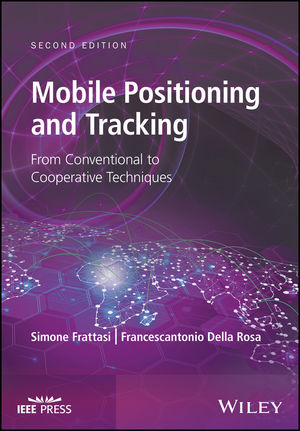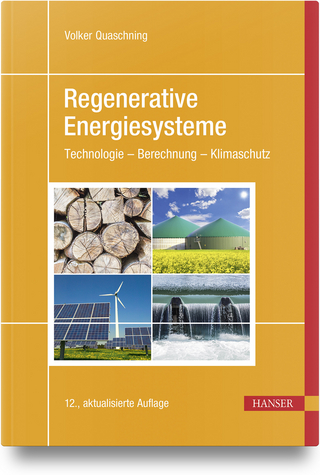
Mobile Positioning and Tracking
Wiley-IEEE Press (Verlag)
978-1-119-06881-5 (ISBN)
The essential guide to state-of-the art mobile positioning and tracking techniques—fully updated for new and emerging trends in the field
Mobile Positioning and Tracking, Second Edition explores state-of-the-art mobile positioning solutions applied on top of current wireless communication networks. Application areas covered include positioning, data fusion and filtering, tracking, error mitigation, both conventional and cooperative positioning technologies and systems, and more. The authors fill the gap between positioning and communication systems, showing how features of wireless communications systems can be used for positioning purposes and how the retrieved location information can be used to enhance the performance of wireless networks.
Unlike other books on the subject, Mobile Positioning and Tracking: From Conventional to Cooperative Techniques, 2nd Edition covers the entire positioning and tracking value chain, starting from the measurement of positioning signals, and offering valuable insights into the theoretical fundamentals behind these methods and how they relate to application areas such as location-based services, as well as related disciplines and professional concerns, including global business considerations and the changing laws and standards governing wireless communication networks.
Fully updated and revised for the latest developments in the field, this Second Edition:
Features new chapters on UWB positioning and tracking, indoor positioning in WLAN, and multi-tag positioning in RFID
Explores an array of positioning and tracking systems based on satellite and terrestrial systems technologies and methods
Introduces advanced and novel topics such as localisation in heterogeneous and cooperative scenarios
Provides a bridge between research and industry with potential implementations of the solutions presented
Mobile positioning and tracking is subject to continuous innovations and improvements. This important working resource helps busy industry professionals and practitioners—including software and service developers—stay on top of emerging trends in the field. It is also a valuable reference for advanced students in related disciplines studying positioning and mobile technologies.
Simone Frattasi, PhD, is currently Head of the Patent Section of Sony Mobile Communications in Lund, Sweden. Previously, he worked as Technical Project Manager at Aalborg University, Denmark. Francescantonio Della Rosa, MSc, works on hybrid data fusion and software development for GNSS receiver prototypes and mobile devices within the EU FP7 project, GRAMMAR (Galileo Ready Advanced Mass Market Receiver), at Tampere University of Technology, Finland.
About the Authors xv
List of Contributors xvii
Preface xix
Acknowledgements xxi
List of Abbreviations xxiii
Notations xxxi
1 Introduction 1
Joaõ Figueiras, Francescantonio Della Rosa and Simone Frattasi
1.1 Application Areas of Positioning (Chapter 2) 5
1.2 Basics of Wireless Communications for Positioning (Chapter 3) 5
1.3 Fundamentals of Positioning (Chapter 4) 5
1.4 Data Fusion and Filtering Techniques (Chapter 5) 6
1.5 Fundamentals of Tracking (Chapter 6) 6
1.6 Error Mitigation Techniques (Chapter 7) 7
1.7 Positioning Systems and Technologies (Chapter 8) 7
1.8 Ultrawideband Positioning and Tracking (Chapter 9) 8
1.9 Indoor Positioning in WLAN (Chapter 10) 8
1.10 Cooperative Multi-tag Localization in RFID Systems (Chapter 11) 9
1.11 Cooperative Mobile Positioning (Chapter 12) 9
2 Application Areas of Positioning 11
Simone Frattasi
2.1 Introduction 11
2.2 Localization Framework 11
2.3 Location-based Services 13
2.3.1 LBS Ecosystem 13
2.3.2 Taxonomies 15
2.3.3 Context Awareness 26
2.3.4 Privacy 29
2.4 Location-based Network Optimization 32
2.4.1 Radio Network Planning 32
2.4.2 Radio Resource Management 32
2.5 Patent Trends 35
2.6 Conclusions 39
3 Basics of Wireless Communications for Positioning 43
Gilberto Berardinelli and Nicola Marchetti
3.1 Introduction 43
3.2 Radio Propagation 44
3.2.1 Path Loss 45
3.2.2 Shadowing 48
3.2.3 Small-scale Fading 49
3.2.4 Radio Propagation and Mobile Positioning 52
3.2.5 RSS-based Positioning 54
3.3 Multiple-antenna Techniques 55
3.3.1 Spatial Diversity 55
3.3.2 Spatial Multiplexing 56
3.3.3 Gains Obtained by Exploiting the Spatial Domain 57
3.3.4 MIMO and Mobile Positioning 59
3.4 Duplexing Methods 59
3.4.1 Simplex Systems 59
3.4.2 Half-duplex 59
3.4.3 Full Duplex 60
3.5 Modulation and Multiple-access Techniques 61
3.5.1 Modulation Techniques 61
3.5.2 Multiple-access Techniques 65
3.5.3 OFDMA and Mobile Positioning 67
3.6 Radio Resource Management and Mobile Positioning 67
3.6.1 Handoff, Channel Reuse and Interference Adaptation 67
3.6.2 Power Control 69
3.7 Synchronization 70
3.7.1 Centralized Synchronization 70
3.7.2 Distributed Synchronization 71
3.8 Cooperative Communications 72
3.8.1 Cooperative MIMO 73
3.8.2 Clustering 74
3.8.3 Cooperative Routing 75
3.8.4 RSS-based Cooperative Positioning 75
3.9 Cognitive Radio and Mobile Positioning 75
3.10 Conclusions 78
4 Fundamentals of Positioning 81
João Figueiras
4.1 Introduction 81
4.2 Classification of Positioning Infrastructures 81
4.2.1 Positioning-system Topology 82
4.2.2 Physical Coverage Range 83
4.2.3 Integration of Positioning Solutions 84
4.3 Types of Measurements and Methods for their Estimation 85
4.3.1 Cell ID 85
4.3.2 Signal Strength 85
4.3.3 Time of Arrival 86
4.3.4 Time Difference of Arrival 87
4.3.5 Angle of Arrival 88
4.3.6 Personal-information Identification 89
4.4 Positioning Techniques 89
4.4.1 Proximity Sensing 89
4.4.2 Triangulation 91
4.4.3 Fingerprinting 95
4.4.4 Dead Reckoning 98
4.4.5 Hybrid Approaches 98
4.5 Error Sources in Positioning 100
4.5.1 Propagation 100
4.5.2 Geometry 104
4.5.3 Equipment and Technology 105
4.6 Metrics of Location Accuracy 106
4.6.1 Circular Error Probability 106
4.6.2 Dilution of Precision 106
4.6.3 Cramér–Rao Lower Bound 107
4.7 Conclusions 107
5 Data Fusion and Filtering Techniques 109
João Figueiras
5.1 Introduction 109
5.2 Least-squares Methods 110
5.2.1 Linear Least Squares 111
5.2.2 Recursive Least Squares 112
5.2.3 Weighted Nonlinear Least Squares 113
5.2.4 The Absolute/Local-minimum Problem 117
5.3 Bayesian Filtering 117
5.3.1 The Kalman Filter 118
5.3.2 The Particle Filter 124
5.3.3 Grid-based Methods 126
5.4 Estimating Model Parameters and Biases in Observations 126
5.4.1 Precalibration 127
5.4.2 Joint Parameter and State Estimation 127
5.5 Alternative Approaches 128
5.5.1 Fingerprinting 128
5.5.2 Time Series Data 131
5.6 Conclusions 132
6 Fundamentals of Tracking 135
João Figueiras
6.1 Introduction 135
6.2 Impact of User Mobility on Positioning 136
6.2.1 Localizing Static Devices 136
6.2.2 Added Complexity in Tracking 136
6.2.3 Additional Knowledge in Cooperative Environments 136
6.3 Mobility Models 137
6.3.1 Conventional Models 137
6.3.2 Models Based on Stochastic Processes 137
6.3.3 Geographical-restriction Models 144
6.3.4 Group Mobility Models 146
6.3.5 Social-based Models 147
6.4 Tracking Moving Devices 150
6.4.1 Mitigating Obstructions in the Propagation Conditions 150
6.4.2 Tracking Nonmaneuvering Targets 151
6.4.3 Tracking Maneuvering Targets 152
6.4.4 Learning Position and Trajectory Patterns 155
6.5 Conclusions 160
7 Error Mitigation Techniques 163
Ismail Guvenc
7.1 Introduction 163
7.2 System Model 165
7.2.1 Maximum-likelihood Algorithm for LOS Scenarios 166
7.2.2 Cramér–Rao Lower Bounds for LOS Scenarios 167
7.3 NLOS Scenarios: Fundamental Limits and Maximum-likelihood Solutions 170
7.3.1 ML-based Algorithms 170
7.3.2 Cramér–Rao Lower Bound 173
7.4 Least-squares Techniques for NLOS Localization 175
7.4.1 Weighted Least Squares 175
7.4.2 Residual-weighting Algorithm 176
7.5 Constraint-based Techniques for NLOS Localization 178
7.5.1 Constrained LS Algorithm and Quadratic Programming 178
7.5.2 Linear Programming 178
7.5.3 Geometry-constrained Location Estimation 180
7.5.4 Interior-point Optimization 181
7.6 Robust Estimators for NLOS Localization 182
7.6.1 Huber M-estimator 182
7.6.2 Least Median Squares 183
7.6.3 Other Robust Estimation Options 184
7.7 Identify and Discard Techniques for NLOS Localization 184
7.7.1 Residual Test Algorithm 184
7.8 Conclusions 188
8 Positioning Systems and Technologies 189
Andreas Waadt, Guido Bruck and Peter Jung
8.1 Introduction 189
8.2 Satellite Positioning 190
8.2.1 Overview 190
8.2.2 Basic Principles 191
8.2.3 Satellite Positioning Systems 194
8.2.4 Accuracy and Reliability 195
8.2.5 Drawbacks When Applied to Mobile Positioning 195
8.3 Cellular Positioning 196
8.3.1 Overview 196
8.3.2 GSM 197
8.3.3 UMTS 206
8.3.4 LTE 208
8.3.5 Emergency Applications in Cellular Networks 211
8.3.6 Drawbacks When Applied to Mobile Positioning 213
8.4 Wireless Local/Personal Area Network Positioning 213
8.4.1 Solutions on Top of Wireless Local Networks 213
8.4.2 Dedicated Solutions 217
8.5 Ad hoc Positioning 220
8.6 Hybrid Positioning 220
8.6.1 Heterogeneous Positioning 220
8.6.2 Cellular and WLAN 221
8.6.3 Assisted GPS 221
8.7 Conclusions 223
Acknowledgements 223
9 Ultra-wideband Positioning and Tracking 225
Davide Dardari
9.1 Introduction 225
9.2 UWB Technology 226
9.2.1 History and Definitions 226
9.2.2 Theory 226
9.2.3 Regulations 228
9.3 The UWB Radio Channel 230
9.3.1 Path Loss 231
9.3.2 Multipath 231
9.3.3 UWB Channel Models for Positioning 232
9.4 UWB Standards 233
9.4.1 IEEE 802.15.4a Standard 233
9.4.2 IEEE 802.15.4f Standard 235
9.4.3 Other Standards 237
9.5 Time-of-arrival Measurements 237
9.5.1 Two-way Ranging 237
9.5.2 Time Difference of Arrival 238
9.5.3 Fundamental Limits in TOA Estimation 238
9.5.4 Main Issues in TOA Estimation 240
9.5.5 Clock Drift 242
9.6 Ranging Algoritms in Real Conditions 243
9.6.1 ML TOA Estimation in the Presence of a Multipath 243
9.6.2 Clock Drift Mitigation 248
9.6.3 Localization and Tracking with UWB 250
9.7 Passive UWB Localization 253
9.7.1 UWB-RFID 253
9.8 Conclusions and Perspectives 258
Acknowledgments 260
10 Indoor Positioning in WLAN 261
Francescantonio Della Rosa, Mauro Pelosi and Jari Nurmi
10.1 Introduction 261
10.2 Potential and Limitations of WLAN 262
10.3 Empirical Approaches 263
10.3.1 Probe Requests and Beacon Frames 264
10.3.2 Positioning Methods 265
10.3.3 Evaluation Criteria for Indoor Positioning Systems Based on WLANs 272
10.4 Error Sources in RSS Measurements 274
10.4.1 Heterogeneous WiFi Cards 275
10.4.2 Device Orientation 277
10.4.3 Channel in the Presence of the User and Body Loss 278
10.4.4 The Hand Grip 278
10.5 Experimental Activities 279
10.6 Conclusions 281
11 Cooperative Multi-tag Localization in RFID Systems: Exploiting Multiplicity, Diversity and Polarization of Tags 283
Tanveer Bhuiyan and Simone Frattasi
11.1 Introduction 283
11.2 RFID Positioning Systems 285
11.2.1 Single-tag Localization 285
11.3 Cooperative Multi-tag Localization 286
11.3.1 Multi-tagged Objects and Persons 286
11.3.2 Localization of Mobile RFID Readers: CoopAOA 290
11.3.3 Performance Evaluation 297
11.3.4 Experimental Activity for Tag Localization 309
11.4 Conclusions 314
12 Cooperative Mobile Positioning 315
Simone Frattasi, Joaõ Figueiras and Francescantonio Della Rosa
12.1 Introduction 315
12.2 Cooperative Localization 316
12.2.1 Robot Networks 316
12.2.2 Wireless Sensor Networks 317
12.2.3 Wireless Mobile Networks 321
12.3 Cooperative Data Fusion and Filtering Techniques 323
12.3.1 Coop-WNLLS: Cooperative Weighted Nonlinear Least Squares 323
12.3.2 Coop-EKF: Cooperative Extended Kalman Filter 326
12.4 COMET: A Cooperative Mobile Positioning System 328
12.4.1 System Architecture 328
12.4.2 Data Fusion Methods 330
12.4.3 Performance Evaluation 337
12.5 Experimental Activity in a Cooperative WLAN Scenario 349
12.5.1 Scenario 350
12.5.2 Results 350
12.6 Conclusions 352
References 353
Index 373
| Erscheinungsdatum | 19.08.2017 |
|---|---|
| Reihe/Serie | Wiley - IEEE |
| Sprache | englisch |
| Maße | 170 x 244 mm |
| Gewicht | 794 g |
| Themenwelt | Technik ► Elektrotechnik / Energietechnik |
| Technik ► Nachrichtentechnik | |
| ISBN-10 | 1-119-06881-9 / 1119068819 |
| ISBN-13 | 978-1-119-06881-5 / 9781119068815 |
| Zustand | Neuware |
| Informationen gemäß Produktsicherheitsverordnung (GPSR) | |
| Haben Sie eine Frage zum Produkt? |
aus dem Bereich


